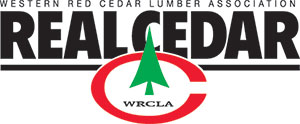This CE Center article is no longer eligible for receiving credits.
Today’s overarching design trends have made sustainability a core competency for architects and project teams. No longer content to talk about green building as a special knowledge area, it is viewed more as a core aspect of good design—the “sustainability competence” that Gaia Architects’ Sandy Halliday wrote about a few years ago in her book, Sustainable Construction. On top of that, sustainability has expanded in its definition and application to include considerations about human health and physiological function as well as psychological wellbeing and social and cultural underpinnings. Indeed, today’s green thinking pervades practically every aspect of human experience and certainly every phase of building planning and operations.
For this reason and others, certain areas of building material selection have become highly complex. Issues to consider in the project planning and schematic design phases include: How durable and resilient is the product? Which, if any, health issues are raised in its use, including material toxicity? What goes into the product’s extraction and manufacture? Are there tradeoffs between local supplies and regional transportation or imported goods? Is the product innately appealing, and are there other similar humanistic considerations? How is it cleaned? What options are available for disposal at end of life?
The list goes on. Answering these questions has led architects to the use of certain materials that are either highly novel—electrochromic glazing, for example—or long-established and conventional, such as masonry and wood. In this latter category, the more traditional products are often deployed as part of innovative assemblies that enhance their value and positive attributes. Architects working with Western Red Cedar, for example, have recently begun exploring new aesthetic territory by combining various patterns and sizes as well as by employing knotty grades, which can project a rustic or graphic appearance, as opposed to the cleaner look of clear grades. Other novel directions include the use of a charred finish, which renders a sleek, slate-gray hue or a deeper char with patterns resembling alligator skin.
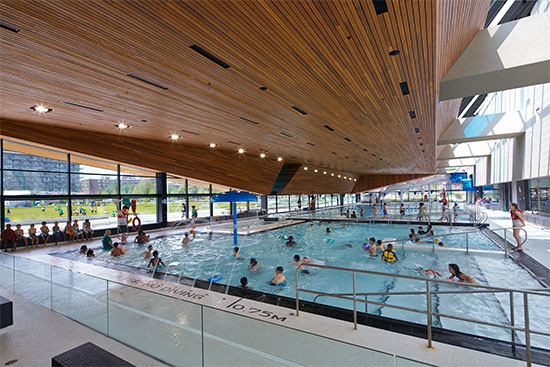
Photo courtesy of Shai Gil Fotography
The award-winning, sustainably designed Regent Park Aquatic Centre in Toronto designed by MacLennan Jaunkalns Miller Architects employs Western Red Cedar for its large and expressive soffit.
In spite of their associations with residential vernacular, Western Red Cedar and other natural materials are increasingly specified for commercial and institutional facilities. Examples include retail and hospitality buildings as well as new educational structures around the country. Toronto’s award-winning, super-modern natatorium by MacLennan Jaunkalns Miller Architects presents an undulating zinc facade connecting to a monumental soffit of Western Red Cedar, applied as a tongue-and-groove system outside and as interior slats with an acoustical underlay. Other approaches have included the decorative weave applications by Urban Arts Architecture for the expressive and sprawling T’it’q’et Community Hall + Health Centre, or the mast-supported overhang protecting a branch of the Salmon Arm Savings & Credit Union by RATIO Architecture Interior Design + Planning Inc., both in British Columbia.

©andrea calo
More projects today use Western Red Cedar on both exterior and interior surfaces, such as the Brady Lane Residence in Texas by Webber + Studio Architects, unifying the composition and exploiting the material’s green attributes.
These projects are not only acclaimed for their formal and material innovation. They are also sustainable, resilient long-term solutions for their clients. To study the green potential of any method or material, an essential part of green building today is the life-cycle assessment (LCA), a detailed analysis that allows for “the most environmentally friendly decisions throughout product design,” according to Dassault Systèmes, which makes automated LCA tools. “The analysis looks at a product’s entire life, which encompasses extraction, material production, manufacturing, product use, end-of-life disposal, and all of the transportation that occurs between these stages.“
Recent LCA studies have helped compare multiple material types. Among the most compelling is one analysis by the research laboratory FPInnovations-Forintek demonstrating the benefits of the wood species Thuja plicata (commonly called Western Red Cedar) against non-wood building materials used for residential siding and decking. The studied materials ranged from relatively novel products such as wood-plastic composite (WPC) to fiber-cement materials to extruded vinyl.
In measurable areas such as resource and water use, energy requirements, transportation implications, and waste creation, the natural wood found mainly in the Pacific Northwest showed substantial advantages for sustainable design. For this reason, says John Wagner, a sustainability consultant and cofounder of the Certified Green Dealer Program, architects and end-users “who previously favored what they considered to be ‘maintenance-free’ materials need to consider this natural alternative, which will help lessen their environmental footprint.” Wagner acknowledges that the LCA showed Western Red Cedar as the least environmentally burdensome and the lowest consumer of nonrenewable resources, such as fossil fuel.
Lauded for years in certain circles for the material’s durability, beauty and value, Western Red Cedar earned a comparative and scientifically reasoned grounding for its environmental benefits. A look at its history, cultivation, building uses, and human factors adds even more weight to what Wagner and others already see as a compelling answer to today’s toughest questions about the core design competency of sustainable design.

Image courtesy of Western Red Cedar Lumber Association
A recent life-cycle assessment or LCA study comparing Western Red Cedar (WRC) to Wood Plastic Composite (WPC) decking products indicates the low total energy requirements for
producing WRC, which helps explain its low impacts for smog and global warming.
High Performance, Human Appeal
LCAs are only a part of the multifaceted analysis conducted by architects and project teams in settling on the best materials for a given application. Another consideration has been called simply humanism by architects like Barry Svigals, FAIA, or “humanistic factors“ that have “gradually become an important factor in green building design,” as China’s materials scientist Li Ting Jiang wrote in the journal Advanced Materials Research last year. The combination of spatial and environmental strategies “encourage green creativity, pay more attention to the interests of the body, strengthen the architect’s responsibility and social orientation, [and] is an effective way to achieve green building goals,“ says LT Jiang, who calls for “incorporating humanistic factors into evaluation standards for green building as soon as possible.”
Humanism extends from the aesthetic response to clinically proven health outcomes, and everything between. At the most analytical, the incorporation of evidence-based design (EBD) into the architecture of hospital environments, for example, shows how built environment variables are linked directly to health outcomes. By 1996, the Center for Health Design had identified 84 studies showing proof of the effectiveness of EBD. Biophilia, a scientific term for the human response to naturally occurring forms such as plants or wood grain, has been described by social ecologist Stephen R. Kellert, author of Biophilic Design, who lists 75 attributes of what he calls “restorative environmental design.” These biophilic elements include natural materials, natural shapes and forms, and natural patterns and processes.
The exposed grain and knots in wood species such as Western Red Cedar, for example, are effective biophilic design elements. Knotty grades, which are always provided in flat-grain constructions so that the knots appear as round shapes, offer especially dynamic natural motifs ranging in tone from light to dark with varied biomorphic markings. A survey of recent projects shows more use of knotty Western Red Cedar, which adds texture and character to surfaces. As seen on the award-winning Minton Hill House in Québec by the firm Affleck + de la Riva Architects, the knotty grades add visual contrast to stone and glass surfaces. In others, like the bayside Lobster Boat Residence in Seattle, Chadbourne + Doss Architects use this memorable knotty wood on exterior surfaces and other design elements, even pairing it with similarly knotty stair treads— illuminating its suitability for salty coastal air as much as its evocative appeal, both indoors and out.
In addition to using knotty grades, some architects integrate cuts of clear grades with flat grain and vertical grain for visual effect, or they employ a random mixture of various-width boards for additional variety in appearance.
Regardless of the grade specified, Western Red Cedar and other wood species have been shown to provide measurable effects on various subjective measures, including “warmth, softness, and a calming effect,” according to Michelle Kam-Biron, S.E., of the trade group WoodWorks. “Principles of evidence-based design show that occupants respond positively to wood,” says Kam-Biron in a recent talk, adding that schools in Japan are built with wood specifically because students respond well to the finishes. Research shows how biophilia relates to humans’ natural predilections for “visual variety, natural irregularity and expressiveness.” This helps explain why architects are applying Western Red Cedar for more indoor and outdoor uses, often in the same building.
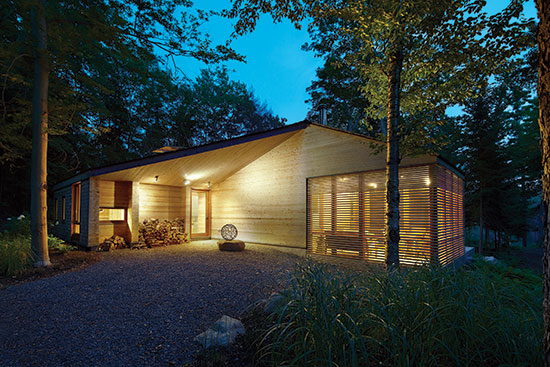
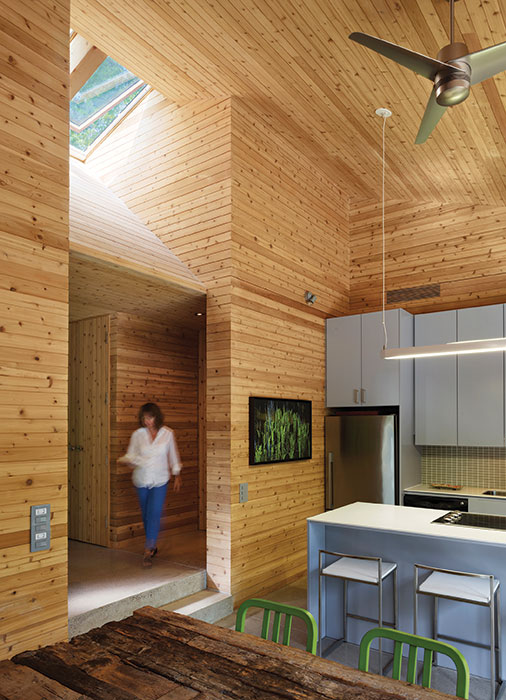
Photos courtesy of Shai Gil Fotography
Some architects are using knotty grades of Western Red Cedar and employing the wood species both indoors and outdoors, as at the Stealth Cabin project near Bracebridge, Ontario, by Toronto-based firm superkül.
Deeply Rooted in Culture, Place
The beneficial effects and attractions of wood appears to be a deeply embedded part of the cultural aspect of architecture, not just pure aesthetics. For example, unlike many construction materials, Western Red Cedar is an intrinsic part of North America’s cultural and environmental heritage. Native Americans in the Pacific Northwest—who commonly referred to themselves as “People of the Cedar”—used two names for this revered tree, which translate as “dry underneath” and “long life maker,” according to nonprofit conservation group American Forests. Also, the Latin name for this type of conifer, arborvitae, means tree of life.
These monikers are more than descriptive. In fact, they signify both spirituality and practical uses, an association that anthropologists describe as arising naturally. For example, on the islands known as Haida Gwaii along British Columbia’s north coast, Western Red Cedar trees have been honored for their age and size, living for more than 1,000 years and growing to 200 feet tall with trunk diameters up to 16 feet, says Paul Mackie, a technical specialist and field representative for the Western Red Cedar Lumber Association (WRCLA). “Even then, the top of the tree continues to grow and is perpetually young, whereas the bottom of the tree is older,” he explains.
After it is harvested, the trees are fragrant, easily worked, and surprisingly light yet stable. Western Red Cedar also has properties to repel moths and insects, and the same natural preservatives are toxic to fungi, yet another benefit for longevity and durability. With such stability and preservative qualities, Western Red Cedar is one of the most resilient materials in the world, according to forestry experts. Pacific Northwest natives—in Canada referred to as First Nations—have used the wood for indoor and outdoor uses including canoes, dance masks, totem poles, and relatively large post-and-beam houses. The knotty imperfections found in many woods, including Western Red Cedar, have figured prominently in their aesthetics. These First Nations have also turned the bark into rope, mats, and clothing, and parts of some Western Red Cedar trees are used for religious and medicinal purposes.
In fact, the tree is still revered, as tribes gather around groves for ceremonies, meditation, and retreat, often conducted before trees are felled by some native groups. Downed trees may be mourned with prayers and offerings in some cases. This reverence for sustainability has not been forgotten: Current forest management practices require that if a tree is culturally modified—for example, marked using methods known to be typical of the First Nations—lumber producers will not harvest the tree. Other kinds of reverence figure into the forest management practices of companies harvesting Western Red Cedar, a tightly standardized supplier group. The core reasoning is that—because Western Red Cedar is integral to air and water quality, climate, biodiversity, health and medicine, and recreation—the forests where Western Red Cedar grows must be carefully managed to ensure the success of future generations.
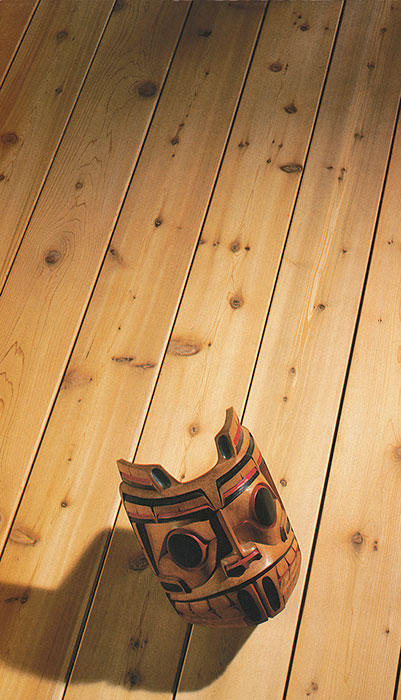
Photo courtesy of Western Red Cedar Lumber Association
Some of the artwork by Native Americans in the Pacific Northwest—often called First Nations —is made of Western Red Cedar, in part because the composition of the revered trees makes the wood objects last for an exceptionally long time.
These careful forest management practices are important to the sustainability of the resulting products. Western Red Cedar manufacturers, architects, and craftsmen tend to highlight cedar’s environmental, economic, and aesthetic value. Western Red Cedar is a unique, beautiful, and durable material for both indoor and outdoor use. These qualities have helped extend the use of Western Red Cedar to build inspiring and nurturing schools, enhance healthcare environments, or to add warmth to the often-cold environment of a modern office complex. It is part of a unique support system for humanistic, sustainable architecture.
LCA Compares Western Red Cedar
With these long-understood benefits, some species of softwoods have been elevated in status as ideal building materials. Western Red Cedar from British Columbia and the Western United States has been tested to quantify its environmental efficacy, and the sustainability data provides environmentalists, architects, and end-users with specific data on how Western Red Cedar contributes to highly sustainable building materials.
With many manufacturers and suppliers and manufacturers touting the environmentally friendly qualities of their products or sourcing methods—many with misleading, single-attribute claims—the WRCLA in 2013 commissioned a third-party LCA to accurately assess Western Red Cedar’s full environmental performance. The life-cycle study was conducted according to the ISO 14040/44 international standard for LCAs, which treats all products equally and calls for peer review following the analysis. The LCA study separately examined several critical stages:
- Cradle-to-gate manufacturing (harvesting, forest management and manufacturing)
- Transportation to clients, installation and use, and end of life (refuse)
- Environmental impact based on six criteria:
- Product or service
- Raw material acquisition
- Energy use and carbon footprint
- Emissions
- Soil and water
- Waste generation
The results on architectural siding and decking produced in Washington State, Oregon, Idaho, Montana, and British Columbia were startling. Western Red Cedar was produced with low-energy extraction and processing methods, and the materials resisted degradation and were found to be highly durable for a softwood product. Comparing Western Red Cedar to virgin and recycled-wood plastic composite decking options, the LCA showed that even in a “worst-case” scenario for Western Red Cedar the wood species would be environmentally favorable as compared to even a “best case” scenario for composite materials, vinyl, fiber-cement, or brick. Summarizing the results, Western Red Cedar was called a “leading building product. . .based on its known three key properties of durability, beauty and value,” according to Jack Draper, WRCLA’s managing director.
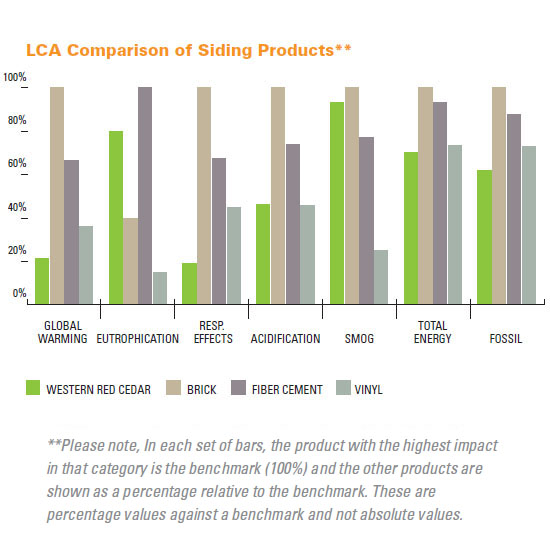
Image courtesy of Western Red Cedar Lumber Association
For siding products, Western Red Cedar was compared to other materials and products in an LCA study of various impacts, including total energy.
Some of the green building benefits of Western Red Cedar are unique among softwood species and also among some widely used hardwoods. First, Western Red Cedar is exclusively harvested in North America. Second, forestry practices for this species have stringent standards for compliance. These two benefits ensure that a building project’s materials are not transported from other continents where forest management regimes may be less reliable or nonstandardized. They also help reduce the likelihood that a given supply will not meet the criteria for green building certification.
A third key quality for sustainable design is that Western Red Cedar is very light in weight, which reduces energy consumption during harvesting and transportation and, to a minor degree, reduces the cost and weight of structural backup systems. For the consideration of transport, however, the benefit is significant in terms of cost and fossil fuel use. WRCLA’s Mackie compares a hypothetical project cladding shipment for a large commercial building: Every vehicle can deliver a full truckload of kiln-dried Western Red Cedar without exceeding the maximum weight allowance, yielding about 20,000 square feet of finished wall. Another cladding product, fiber-cement paneling, weighs more per square foot of facade area. In fact, the trucks cannot be filled completely before they hit the maximum weight allowance, and each truckload will cover only about 8,000 square feet of facade area.
A fourth area of consideration could be called practicality, says Mackie. “Wood is considered a very sensible specification by architects who are knowledgeable about its use,” he explains. “In the building operations phase it is a very low-maintenance item. And overall first costs and operational costs show it to be a cost-effective material selection for cladding, fences and decks, interior paneling, and more.” Mackie adds that the natural supply of Western Red Cedar has remained the same in recent decades, so its supply and price fundamentals are strong. In British Columbia, he adds, about 20 percent of the coastal forests are Western Red Cedar, an incidental species—meaning it does not grow as forests but rather as individual trees. All of the suppliers in the WRCLA meet the requirements of certification and the principles of sustainable forestry.
As a fifth area of consideration, visual appeal and humanistic considerations may not be included in ISO protocols for life-cycle assessment, but an increasing number of architects and related experts urge that these qualities always be considered in building projects. How a place feels makes a big difference in its long-term value, and both indoors and outdoors, woods like Western Red Cedar can have a soothing natural appeal. This ranges from the decorative value and rustic charm when specified in knotty grades, or the modern sophistication imbued by the clear grades.
“People who like being outdoors on a deck usually like being part of their natural surroundings,” says WRCLA’s Mackie, articulating the appeal of natural products as compared to the synthetic character of some composites. “If that’s the case, choosing a natural product like cedar is the way to go,” he adds. “People who like to be outdoors or closer to nature prefer to spend time with all-natural materials.”
From residences to commercial and institutional projects—including midrise and high-rise buildings—many designs are incorporating Western Red Cedar not only on balconies and rooftop decks, but also as facade cladding material. Examples include every store worldwide for Illinois-based retailer Crate & Barrel, and schools like the award-winning, LEED Gold Sandy High School in Sandy, Oregon, designed by Dull Olson Weekes–IBI Group Architects to engage the regional Cascadian architectural style of the famous Timberline Lodge. Other projects include university buildings, public libraries, and dozens of recently built hospitality structures. In many of these cases, architects combine indoor and outdoor uses of the wood to create visual continuity that adds to the natural appeal of the wood surfaces and structures.

Photo courtesy of Josh Partee
An increasing number of building projects using Western Red Cedar are
large-scale commercial and institutional in nature, such as Sandy High School in Oregon, designed by Dull Olson Weekes–IBI Group Architects.
Specifying Western Red Cedar
In this way, Western Red Cedar has entered into the architectural lexicon not only by offering durability and sustainability, but also by offering a varied palette of applications, looks, and finishes. Like many wood species, Western Red Cedar is available in multiple thicknesses, widths, and surface textures. Architects specify either clear or knotty grades, and both can be used indoors and outdoors; an ample range of quality is available in both grades, too. For this reason, either clear or knotty products can be specified for varying degrees of quality and also for a variety of indoor and outdoor applications—from cladding, posts, pergolas, and decks to beams, siding, trim work, decorative elements, and paneling.
The clear grades are considered to have high visual appeal, as the wood has fewer distinctive features or blemishes. The knotty grades display evidence of the branches that once sprouted from the tree. The clear grade choices can be utilized in either a vertical grain (VG) or flat grain (FG), both suitable for walls and cladding and horizontal surfaces such as flooring and decks. Flat grain displays an arching grain shape, which is very readable; vertical grain reads as more subtle parallel striations. Not all grades are available in vertical or flat grain; notably, the knotty grade is not available as vertical grain.
In terms of finishing, Western Red Cedar can be left to age naturally or painted or stained or preserved with oils. A less common but often appealing option is the charred treatment; with this product type, the cedar is treated with fire on its exterior surfaces to enhance its aesthetics. The technique was invented in Japan—called shou sugi ban there—and is mainly an aesthetic effect with negligible effect on the material’s characteristics and performance. Recent projects using the technique include the Prescott Passive House by the University of Kansas School of Architecture’s Studio 804, as well as a modernist office structure designed by THOUGHTBARN, with its two-level “flying” roof, polycarbonate panels and carbonized Western Red Cedar.
Architects can specify fingerjoined (and edge-glued) material, which is available in clear grades. Fingerjoined wood comprises shorter pieces of cedar glued into durable long-length planks. The fingerjoined products can be manufactured with tongue-and-groove, shiplap, and bevel siding patterns, according to the Oregon lumber company Disdero, which specializes in the species. The fingerjoined Western Red Cedar can provide a relatively high value in certain applications, and it is often considered a sustainable method because it is among the most environmentally resourceful.
There are several categories of clear Western Red Cedar, according to the groups that publish grades for building uses: the National Lumber Grades Authority (NLGA), West Coast Lumber Inspection Bureau (WCLIB), the Pacific Lumber Inspection Bureau (PLIB) and Western Wood Products Association (WWPA), all of which are referenced in key industry materials, such as those produced by WRCLA members. Clear Heart is the highest grade, because it is cut with only pieces of the heartwood on the exposed face. Heartwoods of durable wood species— the inner part of the tree—are rot-, decay-, and insect-resistant, according to the Center for Northern Woodlands Education, an organization that advances forest conservation. The living parts of the tree include the sapwood, cambium layer, and inner living bark. In fact, the sapwood in Western Red Cedar is relatively very narrow, generally less than 3/4 inches, which is unusual among tree species; others species of common commercially used woods can contain up to 5 inches of sapwood.
Western Red Cedar contains a naturally occurring palette with a wide range of color, especially in the clear grades. The clear grade has four options other than clear heart, ranging from A Clear to D Clear, and with each successive grade lower, more blemishes are allowed and more cutouts are permitted. The clear grades display a relatively limited number of these natural characteristics, and are often specified or selected for sidings, trim boards, and the like.
Knotty cedar, also supplied kiln-dried, offers more variety in visual characteristics and appearance as it is more casual, rustic, textured, and biomorphic. Knotty cedar grades tend to be suitable for light structural applications such as decking or siding, timbers, panels, and the like. Their length assortments can be supplied with greater average lengths, so the architect and contractors can expect more long pieces in a given assortment. Architects can choose different levels of the knotty grade for decking, timber, trim, or siding. The knots—left by the base of a side branch or a dormant bud—yield areas of hardened, darkened wood in roughly circular patterns around which the grain direction flows. Knots should be sound and tight and, in most cases, round. They have been exploited by architects and crafts contractors for a number of visual effects.
In some recent building projects, architects have mixed the knotty and clear grades of Western Red Cedar to create visual interest or to uniquely distinguish different part of the buildings. Knotty grades are relatively more affordable than clear grades, an added benefit for using knotty grades.
In general, there are four WRCLA product standards to consider for decking applications:
- Architect Clear: This fine-grained decking is manufactured for the demanding clients because it meets the highest manufacturing and quality control standards. It is available seasoned or unseasoned and is a special order product.
- Custom Clear: Also a special-order product, this finely machined product shows more minor blemishes than Architect Clear. Just like Architect Clear, it is available seasoned or unseasoned and is perfect for fine woodworking needs.
- Architect Knotty: Provides rustic charm and durability, with tight knotting and planed (or dressed) to a smooth surface free of skips (areas that are not dressed), all of which make it a more cost-effective and charming alternative. It is available seasoned or unseasoned.
- Custom Knotty: A highly cost-effective option, Custom Knotty is available for knotty cedar decking, and is a fairly affordable option compared to clear and Architect Knotty grades. It is also available seasoned or unseasoned.
Another product standard, Select Knotty, should be specified for knotty trim, siding, and paneling applications.
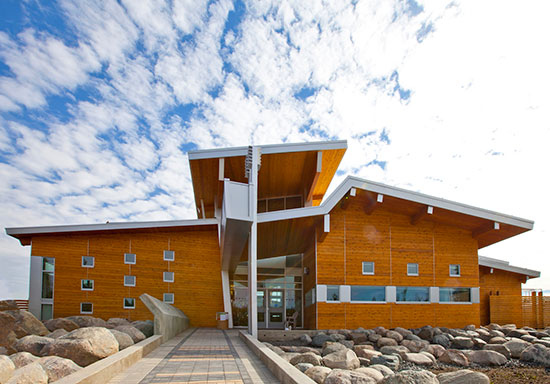
Photo courtesy of Gerry Kopelow Photographics Inc.
The knotty grades of Western Red Cedar are increasingly used on commercial and institutional buildings such as the Victoria Linklater Memorial School in Ontario designed by Victor Kolynchuk – Architecture49 Inc.
In all cases, Western Red Cedar is considered by some architects to be one of the world’s most beautiful woods, especially when applied for both interior and exterior applications on the same building project. By using the same wood for rooms, exterior surfaces and decks or fencing, the architectural composition can blur the lines between indoors and outdoors. Examples include the award-winning Lobster Boat Residence on Seattle’s Portage Bay by Chadbourne + Doss Architects, a modernist composition combining both exterior and interior applications of knotty grades of Western Red Cedar and other woods to achieve a memorable visual effect.
Extending an indoor use of Western Red Cedar to the outdoors—for example, from indoor wall paneling that merges to a matching deck—adds visual continuity and exploits the material’s natural preservatives, which protect against decay and insects. Because the wood is free of pitch and resin, protective coatings such as stains and primers can penetrate deeply into the wood materials; for primer and paint, “There is excellent adhesion,” says Mackie. In addition, architects specify Western Red Cedar for these indoor/outdoor compositions because it stays flat and straight, resists checking, and is firm but resilient. Moreover, because the wood is lightweight, it is easier for contractors to handle than some other species.
Not surprisingly, Western Red Cedar has been part of seaside boardwalk decking for almost a century, similar to other wood species that are not as plentiful. Historically, boardwalk construction often used to be white cedar, as chronicled in 1934 by American botanist Donald Culross Peattie. Later on, to continue building the famous Atlantic City boardwalk, Western Red Cedar was introduced for the famous boardwalk and remained a staple for the next 50 years. On the West Coast, enduring examples are used by tourists and residents year-round. As recently as 2008, Lake Union Park in Seattle opened with an acclaimed new design featuring a rebuilt seawall, gently terraced steps, and a pedestrian boardwalk of Western Red Cedar that has turned to its naturally weathered, soft gray hue.
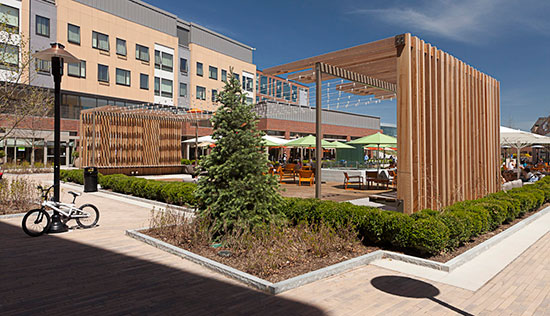
Photo courtesy of Tom Fox
For public boardwalks and large deck areas like architect SWA Group’s Rochester Institute of Technology Global Village and Global Plaza, Western Red Cedar provides durability and resiliency in a selection of thicknesses and widths.
For boardwalks or decking, Western Red Cedar is available in a selection of thicknesses and widths. Maximum recommended spans for decking on joists can support a concentrated load of 220 pounds at the center of one span, according to Bear Creek Lumber, a Washington supplier. In these cases, the decking comprises 2-inch-thick planks up to 6 inches wide; the maximum joist spacing is 24 inches.
Finding the Footprint:
Western Red Cedar and the Environment
Western Red Cedar is a sustainable resource with a low carbon footprint. Created by sun, rain, and naturally occurring nutrients, the trees emit oxygen (O2) and absorb and store carbon (C) when living. This naturally made product is lightweight yet highly stable and strong, so it performs well while requiring much less energy to transport and handle, as compared to other materials.
“The renewable material comes almost exclusively from sustainably and responsibly managed forests in British Columbia, Northern Oregon, Washington, Montana, and Idaho,” says WRCLA’s Mackie, reinforcing the North American provenance of the materials. “Those who manage the various forests are responsible stewards,” he adds, noting that more than 85 percent of timberland in British Columbia is certified by internationally recognized, independent, third-party forest certification agencies that protect biodiversity, soil, and water quality. These not-for-profit agencies include Sustainable Forestry Initiative (SFI), the Canadian Standards Association (CSA), and the Forest Stewardship Council (FSC). British Columbia‘s forest managers must meet or exceed government standards and meet this kind of third-party certification. Forests are assessed according to measurable scientific criteria.
When it comes to forest certification, North America leads the world in scale and expertise. In Canada more than 150 million hectares of forestlands are certified; in the United States, add another 40 million hectares for a total of 200 million hectares (500 million acres) certified in North America. On all these lands, forests are replanted immediately and in-kind. A recent FSC report concluded that more forest companies are certified in North America (39 percent) than South America (less than 7 percent), Africa (about 3 percent) and Asia (just more than 5 percent).
In addition, for many North American building projects, the source of Western Red Cedar is relatively close geographically, and due to its light weight it can be less costly to transport than, for example, plastic composites or fiber cement panels, as shown in the comparison of shipping Western Red Cedar versus fiber cement panels. So with lightweight materials like Western Red Cedar, less fossil fuel is used.
In short, Western Red Cedar not only symbolizes a connection to nature, it also represents responsible and sustainable forest management. In addition, as shown by many new building projects including schools and retail facilities, Western Red Cedar can be used both indoors and outdoors. In recent decades, architects have used the material for interior doors, ceilings, floors, and other custom millwork, and then extended the same wood finishes outdoors with cladding and railings, terraces, decks, gazebos, and the like. For exterior structures, Western Red Cedar can be specified and installed without pre-drilling, which is typically needed for other wood types. Western Red Cedar is less prone to cracking over time because of its malleable composition.
Sustainably harvested softwoods such as Western Red Cedar have been cited as a highly green choice for other reasons. The Minnesota Sustainable Housing Initiative (MSHI), for example, has advocated using Western Red Cedar because it “is energy efficient to produce, and very little waste is produced in its manufacture.” Waste wood can be used for other wood products and even balms. The product is also environmentally efficient for envelope construction because it contributes to low U-values and high R-values. Under a microscope, one can see millions of air-filled cells per cubic inch, which provide effective thermal insulation. Finally, MSHI notes that Western Red Cedar can be applied without need for toxic chemical treatments to provide requisite durability and stability.
In this way, Western Red Cedar is suitable for children’s rooms, playgrounds and school buildings, whether for claddings, railings, decks or seating. Playground equipment of Western Red Cedar is often preferred by school districts as opposed to other materials or finishes.
Western Red Cedar: Stable, High Performance
Western Red Cedar can be found on high-rise buildings, mountaintop villas, waterfront estates, decks, boardwalks and even ships. Because Western Red Cedar is exceptionally stable, it is resistant to warping and rot and also highly weather resistant— performing as required regardless of exposure to sun, wind, and wave, says WRCLA’s Mackie. No matter the grade, Western Red Cedar seems ready to meet the challenges of innovative uses, as it is the most stable softwood according to measures such as elastic modulus, shrinkage percentage, and modulus of rupture given in The Wood Database.
In addition to these raw measures, the full life-cycle attributes of various woods and comparable materials have been studied by groups other than WRCLA. The University of Minnesota’s MSHI, for example, has compared the use of composites, concrete, steel, brick, and metal to wood siding materials, and concluded that wood has the lowest environmental impact, especially if sustainably harvested and maintained. Because Western Red Cedar is harvested to standards audited by third-party inspection agencies, forest management plans control harvest levels and require reforestation to enhance growth stocks, biodiversity, and forest vitality. In British Columbia the forestry practices are guided by ISO 14001, as part of the CSA Z809 Canadian national standard.
These assurances, along with Western Red Cedar’s ability to naturally resist weathering, rot, and insect infiltration, offer architects and their clients reasonable confidence that their buildings are environmentally benign as well as durable and resilient.
Considerations for life-cycle durability also tend to favor Western Red Cedar, which is a softwood even though the word seems to be a misnomer. In fact, Western Red Cedar has twice the stability of commonly available softwoods. Its dimensional stability values are also high for a softwood. It resists warping, twisting, and checking. Low density and specific gravity are actually essential to its stability. WRCLA adds that its heartwood, the face of any cladding, contains Thujaplicins and water-soluble phenols that make it highly resistant to rot and decay. For best performance, savvy architects specify noncorrosive fasteners, such as aluminum, hot-dipped galvanized or stainless steel. Whether clear or knotty grade, paints, stains, oils, or charring are recommended for a longer service life.
The wood species also surpasses steel and concrete in energy efficiency through its qualities of thermal performance, heat conductivity, and insulation, according to WRCLA. Because of its low density—21 pounds per cubic foot and specific gravity of 0.32—Western Red Cedar offers good R-values (and is also easy to transport). Wood siding outperforms metal and glass claddings on R-value because of its high proportion of cell cavities, a natural thermal insulator. “With its low density and high proportion of air spaces, Western Red Cedar is the best thermal insulator among the commonly available softwood species” as compared to brick, concrete, and steel, according to a WRCLA report: Its coefficient of thermal conductivity (k value) is 12 percent mc of 0.74 BTU inch/ft2h degrees F; the R value (the reciprocal of k) for Western Red Cedar is 1.35 R per 1.0 inch (34mm) of thickness.
Other considerations for wood specification include ratings for flame spread and smoke development. For most building types in the United States, the maximum flame-spread rating for interior wall and ceiling finishes is set at 200. Western Red Cedar is tested at a spread rating of 45, which is Class II, based on new testing conducted for the American Wood Council. The flame spread rating for generic lumber, regardless of species, is given as 150 by the Canadian Wood Council (CWC). The criteria for smoke development for most buildings in the United States provides for a maximum smoke-developed classification for interior wall and ceiling finishes of 450; in this case, Western Red Cedar provides a rating of 125, according to CWC. The group notes that flame-spread rating decreases with increasing thickness for wood products up to about 1 inch (25 mm). [Sources: http://cwc.ca/design-with-wood/fire-safety/flame-spread/ ].
A major consideration for certain building types, such as schools or office spaces, is acoustical damping, or the deadening of sound transfer. For this measure, wood also performs well; its cellular network of minute interlocking pores “converts sound energy into heat by frictional and viscoelastic resistance,” according to Mackie, “and because of this high internal friction, wood has more sound damping capacity than most structural materials.”
Knotty Charisma, Indoors and Out
Still, aesthetic considerations are usually the primary driver for selection of wood materials and finishes. In recent years, the “soft modernism” of architects like recent AIA Gold Medal winner Peter Bohlin, FAIA, along with experiments with large-scale, all-timber structures— many with exposed timber elements—have influenced a new generation of modernist wood architecture. Contemporary architecture often juxtaposes wood against modernist materials such as zinc or concrete.
On its own, Western Red Cedar offers versatility and range of design options and unique looks. Varied patterns are possible using custom cuts and traditional profile types, including:
- Bevel siding
- Board-and-batten siding
- Tongue-and-groove siding
- Shiplap siding
- Trim boards
- Shingle panels
In addition, knotty grades expand the options for expression, adding a second level of patterning with its vivid expression. Add to that the charred look of shou sugi ban and the many natural finishes and stains available, and Western Red Cedar contributes exceptional design versatility.
Several recent projects have demonstrated the use of knotty grades and charred finishes of Western Red Cedar, some of them juxtaposed alongside clear grades and other materials. The Red Rock House designed by Anmahian Winton Architects, a one-bedroom dwelling with a guesthouse and garage in Red Rock, New York, is a valuable case study using the knotty grades. This Hudson Valley site, near Albany and the Massachusetts border, is set in a wooded and steep topography. Nick Winton, AIA, chose to soften the linear design of the main house with knotty siding.
Vertical framing for the mixed grade cladding breaks up the horizontal dynamics, says Winton. “The knotty Western Red Cedar provides a grain of rusticity in contrast to the other materials like aluminum and zinc,” Winton says in the publication Cedar Book, Vol. 8. The architects selected three custom-profile, tongue-and-groove boards with stainless-steel fasteners. “The boards are custom milled from mixed grades and with several unique profiles to generate patterns and shadows that change with the sun’s movement,” Winton explains. The result dapples with the sun, and provides clients an environmentally sensitive and durable solution.
In a very different setting, the architects tasked with building a floating house over the fluctuating waters of Lake Huron required an innovative, weather-resistant solution. The result designed by MOS Architects and known as Floating House uses detailed Western Red Cedar cladding. To limit the carbon footprint associated with the building project, Floating House was built on Lake Huron while it was frozen, and then towed about 50 miles to its current location. Using Western Red Cedar also limited the environmental impact, and MOS Architects united indoor and outdoor using cedar for the exterior envelope screen, cladding, and entries as well as other woods for interior wall and ceiling paneling. The firm specified an unfinished knotty grade because the rough texture appealed to the designers and client, and the unfinished wood harmonized with the granite boulders anchored on the winding shores.
“The envelope of the house experiments with cedar siding, which not only encloses the interior living space, but playfully wraps around the exterior spaces as well,” says architect Michael Meredith, AIA, who also teaches at Princeton.
As these projects demonstrate, buildings using Western Red Cedar as part of their designs not only allow for inventive combinations and unique design expression. The material also contributes to a vision for better life-cycle performance and a lighter impact on the environment. For green building that appeals to the senses and psyche, Western Red Cedar reflects our reliance on the earth as well as the debt we owe to nature’s wisdom.
Chris Sullivan is an author and principal of C.C. Sullivan (www.ccsullivan.com), a marketing agency focused on architecture, construction, and building products.
|
The Western Red Cedar Lumber Association represents quality “Real Cedar” producers, distributors and retailers throughout North America. Founded in 1954 and known as “the voice of the cedar industry,” WRCLA offers extensive resources to assist with selection, specification, application and quality standards. www.RealCedar.com |











